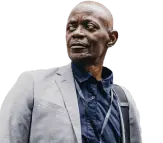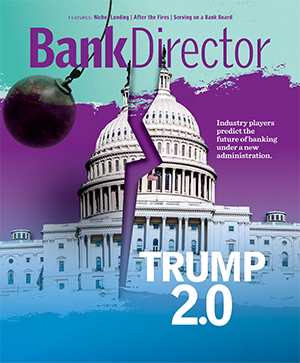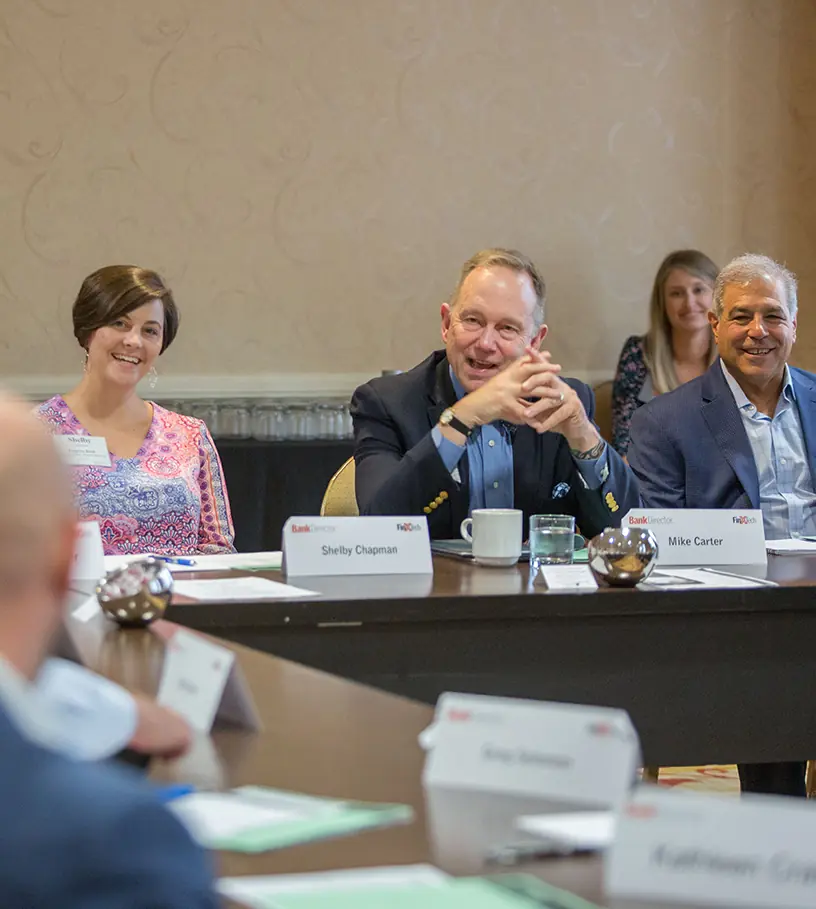
The Maverick
Known for his flashy bow ties and round-rimmed, black-framed glasses, Stephen Cone is nothing if not flamboyant. But it’s been his success in translating such image-building prowess to financial institutions that has made the 48-year-old Cone, now president of retail and corporate marketing for Fidelity Investments, something of a marketing maverick.
The son of a speechwriter for Presidents Nixon and Ford, Cone graduated in 1972 from Coe College in Cedar Rapids, Iowa and spent the next 13 years at Epsilon Data Management, where he became a principal in charge of marketing, database management, and customer service. He joined American Express in 1986 and became head of marketing for Citicorp’s consumer bank in 1992. Two years later, he took the job of chief marketing officer for KeyCorp, where he truly made his mark.
Cone sought to forge a decidedly non-bank branding identity by using personalities and entertainment to give Cleveland-based Key an air of excitementu00e2u20ac”and a human face. During his tenure, Key put discount broker Charles Schwab on the cover of its 1996 annual report and made Anthony Edwards, star of television’s “E.R.,” its national spokesman. He also helped create the idea for ATM machines that double as video games or jukeboxes and leveraged the power of sports by spending $15 million for rights to rename the Seattle Coliseum “KeyArena”u00e2u20ac”a move that boosted consumer awareness of Key in the Northwest manyfold.
Last February, Cone left Key and moved east to head up marketing for behemoth Fidelity Investments. With 12 million customers, 274 funds, and $752.7 billion under management, Fidelity is undisputedly the nation’s largest mutual fund manager. Throw in discount brokerage and total customer assets swell to more than $1.2 trillion. Yet the Boston-based company has struggled for much of the decade to forge a strong brand identity.
In a year’s time, Cone’s handiwork is evident in Fidelity television ads that feature former fund manager Peter Lynch and such stars as Lily Tomlin and Don Rickles. But behind the scenes is where he has been most busy, reorganizing Fidelity’s retail business around customer groups, rather than product groups. He has stepped up its use of data warehousing and miningu00e2u20ac”Fidelity now researches customer attitudes once a quarter, instead of once a yearu00e2u20ac”on a quest to land a greater share of its most-profitable customers’ wallets. And he’s reaching out to banks, seeking to leverage their branch networks and relationships to find new customers.
Always opinionated and rarely at a loss for words, Cone was suffering from a nasty head cold when he sat down with Bank Director one recent morning but showed little sluggishness as he shared insights on his efforts at Fidelity, the present state of financial services marketing, and what banks need to do to position themselves in an increasingly competitive environment.
Banks, he believes, have some great core strengths to leverage. But they often miss the boat by trying to be all things to all people and by positioning themselves as mere “banks”u00e2u20ac”a term he thinks is an image-buster. They also fail at promoting their products and marketing messages to their most important constituency: employees. In Cone’s eyes, there’s plenty of opportunity for banks to grab a bigger piece of customers’ financial pies, if only they position themselves correctly. Andu00e2u20ac”surpriseu00e2u20ac”he says directors have a key role to play in that equation. Below is an edited transcript of our conversation.
Bank Director: What have you sought to do during your first year at Fidelity?
Cone: One of the things that I’ve tried to instill here, which I’ve tried to do my whole career, is to move away from a product focus to a customer focus; to manage customer relationships, as opposed to managing products in the retail group.
The most tangible change is that Fidelity has dramatically increased the amount of attention and service paid to the top 20% of customers in terms of assets. We’re also measuring, like much of the banking industry does, profitability by customer, as opposed to looking at just product profitability issues. Data mining is very important here. It helps us look at the whole relationship that customers have with us, so we can better market to them things that they are interested in, based on their lifestyle and their financial ability.
We get one million customer interactions a day; 85% of that total is electronic, and we’re trying to make that interaction more personalized, with tailored marketing messages on the phone. Soon we’ll be offering personalized home pages for customers on the Web. The great thing about technology is that it’s extremely democratic. It doesn’t matter how large or small your relationship is with us, these types of personalizations apply to all of our customers.
BD: What are the biggest marketing challenges faced by financial services companies, and specifically banks, today?
Cone: It continues to be differentiation. Most banks are in more categories of financial services than they were in past years, and it’s a challenge to try to take a brand name that’s well-known for one particular thing and extend that into other areas that you aren’t traditionally known for.
And it’s even harder to get your message through as an individual entity today, because of the increase in the amount of advertising dollars being spent in the financial services world.
This year there’s slated to be $1 billion in media spending just from mutual fund companies and brokerage housesu00e2u20ac”a 40% increase over four years ago. And that doesn’t include banks or insurance companies or credit card advertisingu00e2u20ac”there’s probably another $2 billion there.
BD: So competitors are marketing more products more aggressively, and at the same time, many of those products are viewed as commodities. How do you set yourself apart?
Cone: Today you have to be much more creative about how you price what may be considered a commodity product. Creative pricing and creating a whole-value proposition is the name of the game today, as well as having very creative promotions, which I don’t think this industry is very good at. Those are two main challenges that marketers have to take on.
BD: How has the competitive landscape changed for banks?
Cone: Part of what’s changedu00e2u20ac”and what makes the last few years of this millennium so greatu00e2u20ac”is that banks can compete and partner with other banks at the same time. You see it all the time. Whether it’s servicing someone else’s credit card portfolio, even though their portfolio is competing directly with yours, or providing other back-end services for competitors, which banks do routinely. I think it stimulates demand for the service and is good for the industry. And it’s good for consumers, too, because it affords them the widest choice.
And there’s the Web. Banks are behind on the Web, but they’ll catch up. They are seeing that the Web is a channel that’s here to stayu00e2u20ac”one that is both very low-cost and can provide huge amounts of business. There clearly will be some banks that get a lot of business from the Web, but at this point I don’t think anyone knows who will come out on top.
BD: With all the attention to partnerships, we hear a lot of concern from bank managements today about brand disintermediation and loss of “customer ownership.” Are those fears justified?
Cone: Nobody knows for sure. What worries banks more than other companies is that they don’t have very good brand differentiation to begin with. If you’re not using a strong personality, and if you don’t have clear differentiation in your advertising message, I think you do run that risk. Banks need to do a better job of trying to differentiate their brands, but it’s not easy.
BD: At KeyCorp, and now at Fidelity, you’ve relied on personalities and entertainment to help create that differentiation. Why?
Cone: People want to buy from people, not from institutions. When you use spokespersons correctly, they can deliver a message in an extremely powerful and credible and passionate fashion. Peter Lynch has been able to do that for us. Chuck Schwab has done it for his company. And you can see other examples throughout the consumer product world, whether it’s Dave Thomas for Wendy’s or Orville Redenbacher.
I think it’s always more interesting to listen to real people, as opposed to composite people who are air-brushed and homogenized and look like they came out of a Pepperidge Farm commercial. And what’s really interesting is that people don’t get tired of them. You have to continually be creative about how you present them and their message. But they become familiar faces and familiar voices. It’s not unlike wanting to watch the same people on the “Today” show day after day.
BD: When you were at KeyCorp, you often said that the word “bank” was detrimental to your marketing efforts. Do you still believe that?
Cone: I do. Certain words mean certain things, and they stick in consumers’ minds for years and years and years.
Very intelligent people disagree on this subject. And to some degree, it’s a matter of how you position yourself. You can work around any name. But my point is, if you don’t have to use the word “bank,” you’re probably better off down the road. And the reason is, because the term “bank” is usually associated in all the research studies that we do with being old-fashionedu00e2u20ac”a place to park money that isn’t going to generate much interest (using all terms of that word)u00e2u20ac”not a place for mutual funds and other investment products, which is where much of the customer interest is today.
When I was at KeyCorp, we were successful at dropping the name “bank” in terms of how we advertised, and we found customer reaction to that was extremely positive.
BD: But certainly banks have some competitive advantages today.
Cone: Sure. They offer one-stop shopping across all categories of financial services. That’s a real positive. They tend to have extremely good technology, especially with regard to the telephone. And they have very good data miningu00e2u20ac”better than a lot of other financial services categories. And, of course, they have strong physical distribution systems, which used to be unpopular, but are now popular again.
As a category, banks are much smarter as marketers than are a lot of other financial services companies. They have done a damn good job of managing the balancing act between customers coming to them directly and going through their branch sales force to purchase partners’ productsu00e2u20ac”something that the insurance companies, for instance, haven’t done as good of a job at.
BD: What banks do you believe are doing a good job of creating an identity that sets them apart from the pack?
Cone: I can probably cite a few. Washington Mutual and Glendale Federal have both done good jobs of producing creative promotions that people pay attention to and enjoy. They do offbeat advertising and go after the competition directly saying, “We’re better than they are,” but they do it with a light touch.
First Union also has very interesting advertising, because, to some degree, it swims against the tide of not wanting to appear to be a huge, monolithic bank. Their advertising, in fact, says they are that. It’s take on kind of a Batman, futuristic approach, and it gets attention. They’re basically taking a chapter out of Marshall McLuhan, the famous media expert, who said, “Like it or not, very effective advertising can often be advertising that kind of gets under your skin, and you can’t get it out.” It may bother you, it may disturb or irritate you, but you’re going to remember it. I think that’s what First Union is doing.
BD: You’ve talked a lot about the importance of creating excitement about new products or services. How can a bank achieve that?
Cone: In order of priority, most financial institutions that market do so in reverse of what they should do. In order of constituency importance, it should be: employees first, customers second, and everyone else third. You have to communicate with, and excite, your employees before you do anything else. But when you analyze how most advertising and marketing budgets are spent, it’s exactly in reverse order.
Employee enthusiasm is crucial. If employees are excited about what you’re doing and understand what you’re doing, that will trickle down to your customers. It’s infectious. But I don’t see anyone consistently doing that well. As an industry, we don’t spend enough money or time telling them why we’re advertising something: what it’s all about, what the benefits are. If you spend as much effort on that as on the next round of advertising, you’re going to get, in my opinion, a much better resultu00e2u20ac”especially since banks have so many employees, who have friends and family.
BD: If you were head of marketing for a bank today, on what would you be focusing your efforts?
Cone: The same things we do here at Fidelity: “What does each major customer segment want, how do our services dovetail with that, and how do we get that message across most effectively?” I’d pick two or three products or services, and really make those zing.
One area of strength for banks that they should focus on is consumer lending, including small-business lending, leasing, loans of all typesu00e2u20ac”home equity, boat loans, car loans, or mortgages. Lending is really the crown jewel of bankingu00e2u20ac”its biggest strength and competitive advantageu00e2u20ac”and I think that will be the case for many years to come. I would push lending like crazy.
BD: People already know they can get a loan at a bank. How would you market it?
Cone: You have to pick niches and really build expertise in a couple of areas, as opposed to just, “We lend money.”
BD: Are there any particular marketing channels that you would emphasize?
Cone: The key is, you’ve got to consistently drive two or three integrated product messages to be successful. What banks tend to do is communicate, “We’ve got a lot of products,” and they try to promote everything, which doesn’t work. And they usually don’t integrate one message very well across all their contact points. You confuse the customer if you say different things in different channels. So pick your two or three greatest product strengths and make sure you’re advertising them consistently through television, print, direct mail, magazines, the Web, and telephone messages.
BD: Are there marketing opportunities that banks are missing right now?
Cone: One thing they don’t do well is something that retailers understand: Deal with post-purchase anxiety. When customers take out a loan, they should immediately be thanked, regardless of what channel they came in at. It’s a very nice touch that will generate a lot more loyalty and business down the road.
Another opportunity is on the reverse side of that. After they’ve paid off a loan, banks should thank customers and suggest that maybe it’s time to take out another loan. That is the perfect leverage point for banks to generate incremental business and incremental customer loyalty. I can’t think of anyone today who thanks customers for paying off their loans.
BD: What role, if any, can bank directors play in shaping a bank’s marketing efforts?
Cone: The biggest thing they can do is to get bank management, if they haven’t already, to come to grips with those two or three things they want to be known foru00e2u20ac”the things they have best-of-class excellence inu00e2u20ac”and not stray from those core businesses.

Join OUr Community
Bank Director’s annual Bank Services Membership Program combines Bank Director’s extensive online library of director training materials, conferences, our quarterly publication, and access to FinXTech Connect.
Become a Member
Our commitment to those leaders who believe a strong board makes a strong bank never wavers.

